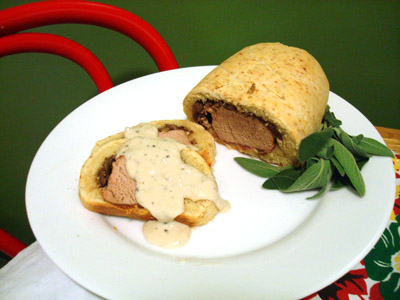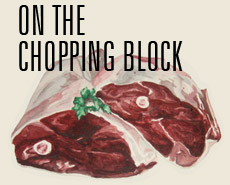Culinary
Transubstantiation
‘Beef Wellington’ travels to the American South
by L. N.
The objective is simple: to translate, literally, a classic dish from one cuisine to another. Not an exercise in fusion cuisine, but rather an ingredient-by-ingredient substitution to the greatest degree possible.

Photograph by L.N.
For this recipe, Britain’s Beef Wellington passes through the filter of the American South. The dish in its original form is essentially beef tenderloin smeared with pâté de foie grois, encased in puff pastry, and served with a Madeira wine sauce. The dish derives its name from the Duke of Wellington, though myths abound as to how an Irish-born general with a purportedly apathetic palate became its namesake. Rumors have circled that it was his meal of choice, or, perhaps more realistically, a mere re-christening of the French dish bœuf en croute.
The recipe lends itself well to translation: there are a variety of replacements for the ingredients, yet the dish has a rigid physical structure, which makes for an end result whose evolution can still be traced (visually, at least). Here the recipe substitutes the Southern mainstays of pork, chicken liver, and biscuits, for beef, foie gras and puff pastry, respectively.
Taste-wise, the dish isn’t a total miss; the tenderloin itself is juicy and well-seasoned, and the biscuit crust is satisfyingly thick and even. Smothered with pepper gravy, the dish was as hearty and as monotone as numerous other Southern favorites (chicken-fried steak, grits, hushpuppies, cornbread dressing...). However, the sausage, which was added to the liver mixture in an attempt to compensate for the fat lost with the foie gras translation, falls short. The flavor and texture would be better served by a dollop of bacon grease, or, more directly, lard, and a quick blend with the food processor. Feel free to experiment with those substitutions below — but why not start from scratch with a recipe of your own choosing, and contribute to the Moon?
INGREDIENTS:
For filling:
- 1 lb. pork tenderloin, roughly 2.25″ in diameter
- 1 bunch fresh sage, roughly chopped
- 3 pork breakfast sausage links
- ½ lb. chicken livers (soaked in milk for two hours, then rinsed and drained)
- 3 Tbsp. salted butter
- 6 white mushrooms, finely diced
- 1 small onion, finely diced
- salt and freshly ground pepper to taste
For biscuit crust:
- 2 cups flour + additional for dusting
- 6 Tbsp. butter, diced
- 1¼ cups whole milk
- pinch of salt
For gravy:
- 1 Tbsp. butter
- ¼ cup + 1 Tbsp. flour
- ½ cup whole milk
- 2 tsp. freshly ground pepper
- salt to taste
Serves 4
PREPARATION:
Begin with the biscuit crust: combine the flour and butter with your hands, mixing well, until the consistency resembles coarse sand. Add the milk, ¼ cup at a time, stirring between each addition. Gently knead mixture, adding additional flour if necessary, and set in the fridge. Preheat oven to 375° F.
Remove sausage from casing and melt 2 tablespoons of butter in a saucepan over medium high heat. Add sausage, mushrooms, onion, sage, salt and pepper. Sauté for 5 minutes, breaking up sausage into small pieces. Next, add chicken livers and sauté until just done, about 5 more minutes. Remove from heat, transfer to a mixing bowl and set aside to cool.
Next, melt 1 tablespoon of butter in ovenproof frying pan over medium high heat and liberally season the pork with salt and pepper. As soon as butter is completely melted, add the tenderloin to pan and brown on all sides (including ends), about 3–4 minutes total. Transfer pan directly into preheated oven and roast for approximately 15 minutes. Remove from oven and allow tenderloin to cool for 10 minutes.
Return to the liver mixture. Using a fork, mash the ingredients into a rough paste. Then remove biscuit dough from fridge, place on a flour-dusted surface, and roll out to ½-inch thickness. The dough should be just large enough to comfortably encase the tenderloin, roughly 1′ x 8″. Spread the liver mixture over the dough, leaving two inches on each side. Center the tenderloin on the liver and then pull the dough around lengthwise, barely overlapping the seam (trim any overlap over ¼ inch). Fold up the ends, again trimming any excess dough, and then place the loin seam-side down on a baking sheet.
Place baking sheet in the oven (still at 375° F) and bake for 15 minutes or until crust is golden brown. Meanwhile, place the frying pan used to cook the tenderloin over medium heat (caution: the handle will be hot from earlier baking). Add 1 tbsp. butter and 1 tbsp. flour. Stir rapidly until a paste forms. Quickly whisk in the milk, stirring constantly. Add the remaining flour in 3 stages while continuing to whisk. Once mixture is creamy, add salt and pepper. Reduce heat to low. If gravy becomes too thick, increase heat to medium and add additional milk until desired consistency is achieved.
Allow the tenderloin to rest for 5 minutes, then cut into ½″ slices. Serve with pepper gravy.








